www.industryemea.com
10
'24
Written on Modified on
SUSTAINABLE AVIATION FUEL: CURRENT STATUS AND FUTURE PROSPECTS
Milton D’Silva presents an overview of the current scenario in Sustainable Aviation Fuel.
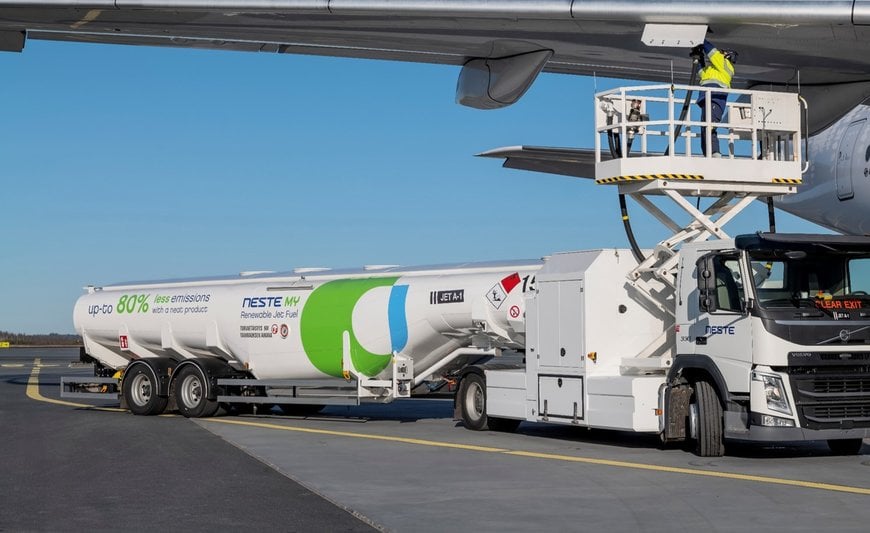
Neste MY Sustainable Aviation Fuel is a direct replacement for fossil jet fuel. Image source: Neste
The world faces a serious problem of climate change caused by greenhouse gas (GHG) emissions. It is a widely known and accepted fact that GHG emissions, by trapping the heat of the sun in the earth’s atmosphere, cause global warming and the resultant climate change. The latter is evident from growing instances of extreme weather events – intense heat waves, floods, sporadic wildfires, tropical storms and hurricanes, causing much havoc, death and destruction. Another serious effect is the rise in sea level, which besides increasing the risks of flooding will also cause a shortage of potable drinking water. GHG emissions are caused mainly by human activities, most notably the use of fossil fuels (coal, oil & gas), the burning of which releases carbon dioxide (CO2), which account for over 75% of the GHG emissions. While carbon emissions and GHG emissions are not the same, CO2 is a major constituent of GHG emissions. Other emissions are caused by industrial activities, use of fertilizers, animal husbandry, deforestation, improper waste management and waste water treatment, etc.
Energy and transportation are among the biggest contributors to global GHG emissions. Within transportation, aviation contributes 2% of global carbon dioxide emissions, besides also causing nitrogen oxides and other emissions, which together contribute 3% of the total GHG emissions. This is also confirmed by a report of the Intergovernmental Panel on Climate Change (IPCC). Though this appears to be a small percentage of GHG emissions in the transportation sector, aviation is today one of the fastest growing transportation segments and hence the need to initiate remedial measures to slow down, halt and reverse the trend, in line with the global quest towards Net Zero. For years, there have been efforts to address the issue, through a host of measures like improvements in airframes and engines, increasing operational efficiency, optimisation of airport operations, and even reducing the need to travel. Yet, one of the more promising measures to curtail GHG emissions in aviation is to promote the use of sustainable aviation fuel (SAF).
What is Sustainable Aviation Fuel (SAF)?
The International Air Transport Association (IATA), the apex trade association of the world's airlines representing around 330 airlines representing 80% of global air traffic, defines Sustainable Aviation Fuel (SAF) as a liquid fuel currently used in commercial aviation which reduces CO2 emissions by up to 80%. It can be produced from a number of sources (feedstock) including waste oil and fats, green and municipal waste and non-food crops. It can also be produced synthetically via a process that captures carbon directly from the air.
The International Civil Aviation Organization (ICAO), a United Nations agency that helps countries develop and regulate civil aviation, defined SAF as renewable or waste-derived aviation fuel that meets sustainability criteria. A technical analysis done at ICAO shows that SAF has the greatest potential to reduce CO2 emissions from International Aviation. In October 2016, the member states of the ICAO adopted a global market-based measure for aviation emissions – the Carbon Offsetting and Reduction Scheme for International Aviation (CORSIA). This is a global offsetting scheme, whereby airlines and other aircraft operators will offset any growth in CO2 emissions above 2020 levels.
The Office of Energy Efficiency & Renewable Energy, USA, defines SAF as biofuel used to power aircraft that has similar properties to conventional jet fuel but with a smaller carbon footprint. Depending on the feedstock and technologies used to produce it, SAF can reduce life cycle GHG emissions dramatically compared to conventional jet fuel.
How different is SAF from Aviation Turbine Fuel (ATF)?
Conventionally, commercial aircraft, powered by gas-turbine or jet engines, use aviation turbine fuel (ATF), which is a hydrocarbon-based fuel refined directly from crude oil. In simple terms, it is high purity kerosene-based fuel with – a low cost fuel with high flash point that makes it safer for transportation. ATF, in general, is a colourless fuel that contains additives to improve fuel performance and handling. There are many different types of ATF, including Jet A, Jet A-1, and Jet F-34/JP-8. Each type has different characteristics, such as freezing points.
SAF and ATF differ in several ways, in that SAF is made from renewable or waste sources, while ATF is a conventional jet fuel derived from fossil fuels. SAF has a smaller carbon footprint than ATF, as it is made up of 67% isoalkanes, 25% normal-alkanes, and 8% aromatics, while conventional jet fuel is a blend of over 2,000 chemicals.
SAF can be produced from waste materials like household food waste and cooking oils, municipal/agriculture/forest waste or can be created synthetically from captured carbon dioxide and renewable electricity. ATF, on the other hand, is extracted from the ground and releases previously stored carbon into the atmosphere.
In terms of environmental impact, SAF can reduce life cycle GHG emissions by at least 60% compared to ATF, which releases CO2 emissions and has other warming effects due to nitrogen oxides (NOx), vapour trails, and cloud formation.
Airbus Industrie, which has a 60% market share of the civil aviation industry, emphasises that its aircraft are capable of flying on a maximum 50% blend of SAF and conventional fuel. However, by 2030, all Airbus aircraft and helicopters will be capable of flying with up to 100% SAF, it states. Boeing, the other major player, also agrees that SAF offers the largest potential to reduce those emissions over the next 20 to 30 years. Boeing has been a pioneer in making SAF a reality and believes aviation should be a priority user of sustainable fuel.
SAF can be blended with traditional jet fuel (kerosene) up to a maximum of 50%.
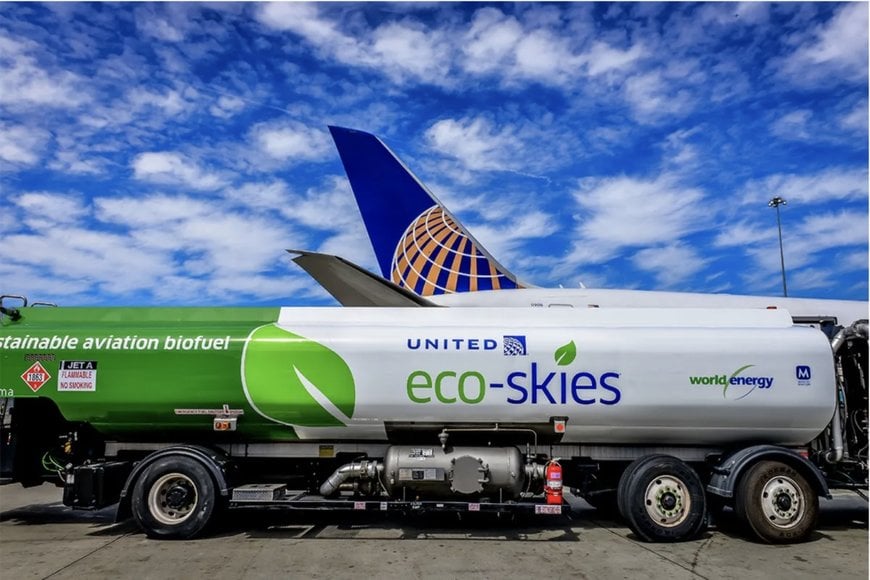
World Energy's SAF is made entirely of renewable resources and contains no fossil-based feedstock. Image source: World Energy
Types of SAF
SAF today is no longer an experimental fuel. Leading aviation regulatory authorities of the world including IATA and ICAO mentioned earlier, as well as the US Federal Aviation Administration (FAA), the European Aviation Safety Agency (EASA) among others, have already put in place clear guidelines allowing the use of SAF. These organisations have also instituted compliance mechanisms to monitor the use of SAF by its members. Yet, SAF is not a single formula fuel. As noted earlier, it is a low-carbon replacement for fossil-based jet fuel that meets ASTM standards for jet fuel safety. ASTM International (American Society for Testing and Materials) is an international organisation at which technical standards for a wide range of materials, products, processes, systems, and services are developed. In the aviation fuel industry, ASTM serves as the international standard for jet fuel quality, and plays a crucial role in ensuring safety, quality, and reliability of SAF, which is produced from a variety of renewable feedstocks and comes in different types. ASTM D7566 is the governing specification for SAF, which is in addition to the D1655 standard meant for conventional jet fuel. ASTM D7566 is regularly updated as and when a new manufacturing process is approved. For a new SAF production pathway to be included in D7566, the fuel must undergo extensive testing to define the maximum blend ratio with conventional jet fuel and demonstrate such blend is fit for purpose. In effect, this means that SAF is certified to the same global specifications as conventional jet fuel. Other than ASTM, there is the UK Defence Standard (Def-Stan 91-091) specification that is widely accepted for SAF across the world.
There are several types of sustainable aviation fuels produced presently, which vary in their fuel feedstock type and production technologies. These include, but are not restricted to:
The world faces a serious problem of climate change caused by greenhouse gas (GHG) emissions. It is a widely known and accepted fact that GHG emissions, by trapping the heat of the sun in the earth’s atmosphere, cause global warming and the resultant climate change. The latter is evident from growing instances of extreme weather events – intense heat waves, floods, sporadic wildfires, tropical storms and hurricanes, causing much havoc, death and destruction. Another serious effect is the rise in sea level, which besides increasing the risks of flooding will also cause a shortage of potable drinking water. GHG emissions are caused mainly by human activities, most notably the use of fossil fuels (coal, oil & gas), the burning of which releases carbon dioxide (CO2), which account for over 75% of the GHG emissions. While carbon emissions and GHG emissions are not the same, CO2 is a major constituent of GHG emissions. Other emissions are caused by industrial activities, use of fertilizers, animal husbandry, deforestation, improper waste management and waste water treatment, etc.
Energy and transportation are among the biggest contributors to global GHG emissions. Within transportation, aviation contributes 2% of global carbon dioxide emissions, besides also causing nitrogen oxides and other emissions, which together contribute 3% of the total GHG emissions. This is also confirmed by a report of the Intergovernmental Panel on Climate Change (IPCC). Though this appears to be a small percentage of GHG emissions in the transportation sector, aviation is today one of the fastest growing transportation segments and hence the need to initiate remedial measures to slow down, halt and reverse the trend, in line with the global quest towards Net Zero. For years, there have been efforts to address the issue, through a host of measures like improvements in airframes and engines, increasing operational efficiency, optimisation of airport operations, and even reducing the need to travel. Yet, one of the more promising measures to curtail GHG emissions in aviation is to promote the use of sustainable aviation fuel (SAF).
What is Sustainable Aviation Fuel (SAF)?
The International Air Transport Association (IATA), the apex trade association of the world's airlines representing around 330 airlines representing 80% of global air traffic, defines Sustainable Aviation Fuel (SAF) as a liquid fuel currently used in commercial aviation which reduces CO2 emissions by up to 80%. It can be produced from a number of sources (feedstock) including waste oil and fats, green and municipal waste and non-food crops. It can also be produced synthetically via a process that captures carbon directly from the air.
The International Civil Aviation Organization (ICAO), a United Nations agency that helps countries develop and regulate civil aviation, defined SAF as renewable or waste-derived aviation fuel that meets sustainability criteria. A technical analysis done at ICAO shows that SAF has the greatest potential to reduce CO2 emissions from International Aviation. In October 2016, the member states of the ICAO adopted a global market-based measure for aviation emissions – the Carbon Offsetting and Reduction Scheme for International Aviation (CORSIA). This is a global offsetting scheme, whereby airlines and other aircraft operators will offset any growth in CO2 emissions above 2020 levels.
The Office of Energy Efficiency & Renewable Energy, USA, defines SAF as biofuel used to power aircraft that has similar properties to conventional jet fuel but with a smaller carbon footprint. Depending on the feedstock and technologies used to produce it, SAF can reduce life cycle GHG emissions dramatically compared to conventional jet fuel.
How different is SAF from Aviation Turbine Fuel (ATF)?
Conventionally, commercial aircraft, powered by gas-turbine or jet engines, use aviation turbine fuel (ATF), which is a hydrocarbon-based fuel refined directly from crude oil. In simple terms, it is high purity kerosene-based fuel with – a low cost fuel with high flash point that makes it safer for transportation. ATF, in general, is a colourless fuel that contains additives to improve fuel performance and handling. There are many different types of ATF, including Jet A, Jet A-1, and Jet F-34/JP-8. Each type has different characteristics, such as freezing points.
SAF and ATF differ in several ways, in that SAF is made from renewable or waste sources, while ATF is a conventional jet fuel derived from fossil fuels. SAF has a smaller carbon footprint than ATF, as it is made up of 67% isoalkanes, 25% normal-alkanes, and 8% aromatics, while conventional jet fuel is a blend of over 2,000 chemicals.
SAF can be produced from waste materials like household food waste and cooking oils, municipal/agriculture/forest waste or can be created synthetically from captured carbon dioxide and renewable electricity. ATF, on the other hand, is extracted from the ground and releases previously stored carbon into the atmosphere.
In terms of environmental impact, SAF can reduce life cycle GHG emissions by at least 60% compared to ATF, which releases CO2 emissions and has other warming effects due to nitrogen oxides (NOx), vapour trails, and cloud formation.
Airbus Industrie, which has a 60% market share of the civil aviation industry, emphasises that its aircraft are capable of flying on a maximum 50% blend of SAF and conventional fuel. However, by 2030, all Airbus aircraft and helicopters will be capable of flying with up to 100% SAF, it states. Boeing, the other major player, also agrees that SAF offers the largest potential to reduce those emissions over the next 20 to 30 years. Boeing has been a pioneer in making SAF a reality and believes aviation should be a priority user of sustainable fuel.
SAF can be blended with traditional jet fuel (kerosene) up to a maximum of 50%.

World Energy's SAF is made entirely of renewable resources and contains no fossil-based feedstock. Image source: World Energy
Types of SAF
SAF today is no longer an experimental fuel. Leading aviation regulatory authorities of the world including IATA and ICAO mentioned earlier, as well as the US Federal Aviation Administration (FAA), the European Aviation Safety Agency (EASA) among others, have already put in place clear guidelines allowing the use of SAF. These organisations have also instituted compliance mechanisms to monitor the use of SAF by its members. Yet, SAF is not a single formula fuel. As noted earlier, it is a low-carbon replacement for fossil-based jet fuel that meets ASTM standards for jet fuel safety. ASTM International (American Society for Testing and Materials) is an international organisation at which technical standards for a wide range of materials, products, processes, systems, and services are developed. In the aviation fuel industry, ASTM serves as the international standard for jet fuel quality, and plays a crucial role in ensuring safety, quality, and reliability of SAF, which is produced from a variety of renewable feedstocks and comes in different types. ASTM D7566 is the governing specification for SAF, which is in addition to the D1655 standard meant for conventional jet fuel. ASTM D7566 is regularly updated as and when a new manufacturing process is approved. For a new SAF production pathway to be included in D7566, the fuel must undergo extensive testing to define the maximum blend ratio with conventional jet fuel and demonstrate such blend is fit for purpose. In effect, this means that SAF is certified to the same global specifications as conventional jet fuel. Other than ASTM, there is the UK Defence Standard (Def-Stan 91-091) specification that is widely accepted for SAF across the world.
There are several types of sustainable aviation fuels produced presently, which vary in their fuel feedstock type and production technologies. These include, but are not restricted to:
- SAF from wet waste – A carbon-negative fuel that uses carbon energy from food waste, animal manure, and other wet wastes.
- Bio-based polycyclic alkane SAF – Made from bio-acetone, which can be produced from biomass resources like corn stover or bioenergy crops.
- SAF from carbon-rich waste gases – Uses waste carbon monoxide from industrial processes, which is captured and upgraded into ethanol.
- SAF made from plant feedstock – Uses plants that absorb CO2 through photosynthesis, such as oil seed plants, energy grasses, and agricultural and forestry residue.
- Hydroprocessed Esters and Fatty Acids (HEFA) – Uses waste and residue fats, like vegetable oil, used cooking oil, and animal fats, as well as purposely grown plants like jatropha and camelina
- Alcohol to Jet – Alcohol to Jet (AtJ) converts alcohols such as ethanol and iso-butanol into SAF by removing the oxygen and linking the molecules together.
- eFuels – SAF can be produced using green hydrogen, capturing carbon dioxide, and using renewable electricity to create synthetic fuels. This type of SAF is sometimes referred to as synthetic SAF or eFuel produced by Power-to-Liquid (PtL) and Fischer-Tropsch process
- Algae-based SAF – Algae-based SAFs have the potential to be more environmentally friendly than traditional fuels because they have lower carbon intensities and lower particulate levels. However, the production of algae-based SAFs is still in its early stages.
Current status of SAF adoption
At the 77th IATA Annual General Meeting in Boston, USA, on October 04, 2021, a resolution was passed by IATA member airlines committing them to achieving net-zero carbon emissions from their operations by 2050. This was also supported by the long term aspirational goal (LTAG) adopted by the 41st ICAO Assembly held from September 27 to October 07, 2022. According to IATA, this will require a combination of maximum elimination of emissions at the source, offsetting and carbon capture technologies. IATA envisages achieving this through the following steps:
At the 77th IATA Annual General Meeting in Boston, USA, on October 04, 2021, a resolution was passed by IATA member airlines committing them to achieving net-zero carbon emissions from their operations by 2050. This was also supported by the long term aspirational goal (LTAG) adopted by the 41st ICAO Assembly held from September 27 to October 07, 2022. According to IATA, this will require a combination of maximum elimination of emissions at the source, offsetting and carbon capture technologies. IATA envisages achieving this through the following steps:
- 65% by SAF
- 13% through new technology, electric and hydrogen
- 3% with infrastructure and operational efficiencies, and
- 19% through offsets and carbon capture.
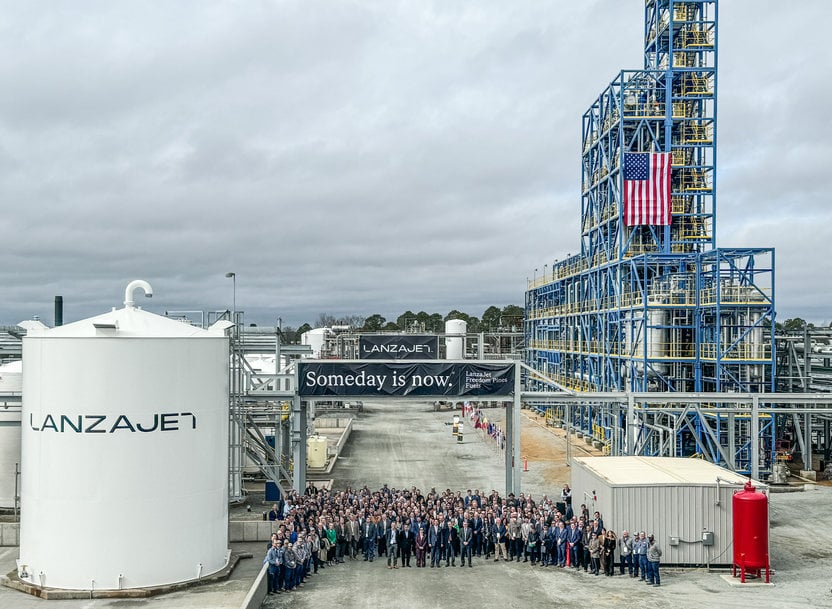
LanzaJet's Freedom Pines facility located in Soperton, Georgia in US. Image source: LanzaJet
The more immediate task however is to achieve a collective global aspirational vision to reduce CO2 emissions in international aviation by 5% by 2030, which is agreed to by ICAO and its over 100 Member States at the third Conference on Aviation and Alternative Fuels (CAAF/3) held in Dubai during November 2023. Against this backdrop, it would be interesting to examine the current status of SAF adoption globally.
The first test flight with SAF was performed by Virgin Atlantic in 2008 with biojet fuel. By 2015, IATA statistics indicate 22 airlines performed over 2,500 commercial passenger flights with blends of up to 50% SAF. In March 2016, United became the first airline to introduce a daily flight in the US from Los Angeles airport with SAF blend. By November 2019, a total of 45 airlines had flown over 2,50,00 flights and gained experience with SAF. 100 million litres of SAF was produced globally in 2021, which tripled to 300 million litres in 2022, and further doubled to 600 million in 2023. Yet this represents only a minuscule 0.2% of the annual requirement of jet fuel presently, which means that it is still not widely adopted globally. On another parameter, the 600 million litres of SAF produced in 2023 accounts for a mere 3% of the total renewable fuel produced globally in 2023 for all sectors, which again indicates the wide gap that SAF must cover in terms of production capacity.
There are several reasons for the poor adoption of SAF globally, but at the moment, the main reason is the high cost of SAF which is almost thrice as much as conventional jet fuel or ATF. According to IATA estimates, even with the fluctuating prices of conventional jet fuel, SAF will still cost 2 to 4 times more than any aviation fuel. Given that fuel costs account for a third of an airline’s operational expenditure, the high cost of SAF will be passed on to customers, impacting business. However, the scenario is far from bleak. Use of SAF is still at the nascent stage and the industry, government and even environment conscious consumers are on the same page, convinced about the need for the Net Zero by 2050 deadline. According to a recent survey by Rocky Mountain Institute (RMI) – an independent, nonpartisan and nonprofit organisation with a stated mission of transforming the global energy system – airlines, logistics service providers, and corporate customers are willing to pay a green premium for SAF. RMI describes this as a classic chicken-and-egg problem where supply and demand are not growing fast enough to meet the emissions reductions targets needed to avoid the worst impacts of climate change.
The other significant challenge is ramping up the production of SAF in anticipation of both – the rising demand for blending SAF and the growing requirement of fuel in an expanding global aviation market which is estimated to double over the next three decades.
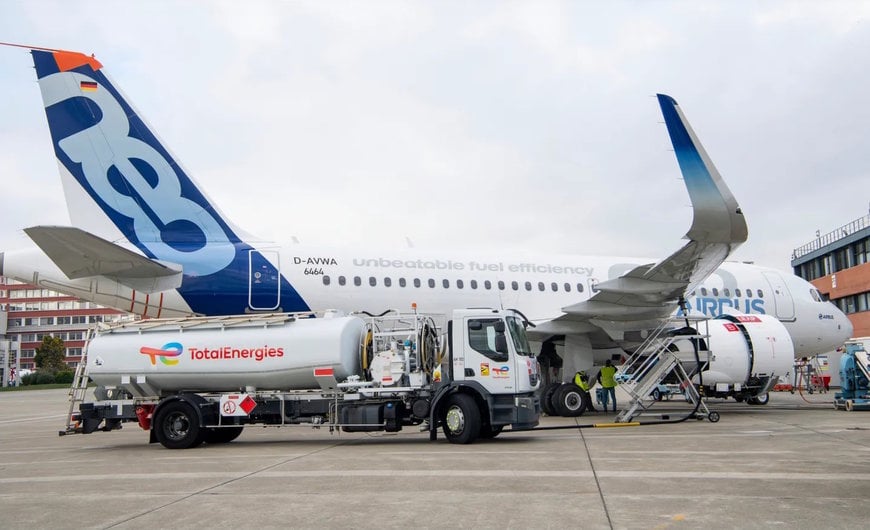
Airbus and TotalEnergies signed a strategic partnership in 2021 for SAF. Image Source: Airbus
Overview of current global SAF production capacity
IATA estimates indicate that for international aviation to be 5% less carbon intensive by 2030 as agreed at the CAAF/3, about 17.5 billion litres (14Mt) of SAF need to be produced.
In 2024, SAF production is expected to triple to 1.875 billion litres (1.5Mt) from the 2023 figure, which is just about 0.5% of aviation’s fuel need. This means in the next six years, production should increase by almost 10X to achieve the 2030 target.
On the positive side, demand is not the constraint as every drop of SAF produced has been bought and used despite the premium in price. A recent survey has also confirmed that an overwhelming 86% of the air travellers are in favour of government support to incentivise SAF production.
According to IATA, the projected annual renewable fuels capacity to cater to the requirements of all industrial and transportation segments by 2029 is over 78 billion litres (63Mt). What it expects governments to do is set up a policy framework to incentivise renewable fuel producers to allocate 25-30% of their output to SAF to meet the 2030 goal. “At those levels aviation will be on the trajectory needed to reach net zero carbon emissions by 2050. Until such levels are reached, we will continue missing huge opportunities to advance aviation’s decarbonisation. It is government policy that will make the difference. Governments must prioritise policies to incentivise the scaling-up of SAF production and to diversify feedstocks with those available locally. They need to deliver policy measures that can achieve the needed exponential increase in SAF production,” said Willie Walsh, IATA’s Director General, quoted in the IATA press release.
Commenting on the agreements reached at CAAF/3, Haldane Dodd, Executive Director of the cross-industry Air Transport Action Group, had said: “A shift towards a replacement of fossil fuels by SAF will require significant investment. The agreement helps to provide another layer of certainty to unlock the trillions in capital needed. Aviation has provided a near-term objective and the global framework. Now it is up to the finance community and energy sector to support the necessary infrastructure and start delivering SAF in ever increasing quantities. We need supportive government policies and supportive investment from the finance sector.”
IATA has summarised the policy framework for effective production incentives for SAF to support the following objectives:
- Accelerating investments in SAF by traditional oil companies
- Ensuring renewable fuel production incentives encourage sufficient SAF quantities
- Focusing stakeholders on regional diversification of feedstock and SAF production
- Identifying and prioritising high potential production projects for investment support, and
- Delivering a global SAF Accounting Framework.
Major SAF producers
Going by a simple search on the internet, there are over 100 companies working on SAF globally. A recent report by McKinsey & Co in fact states that energy majors, airlines, start-ups, and scale-ups are pursuing more than 200 SAF production projects. Not all of these are operational, however – in fact very few are; others are in development, waiting for final investment decisions (FIDs), whereas many are just at the planning stage. The following are among the leading companies engaged in producing SAF:
Neste – The world’s largest producer of renewable diesel and jet fuel refined from waste and residues, introducing renewable solutions also to the polymers and chemicals industries. Neste MY Sustainable Aviation Fuel is a direct replacement for fossil jet fuel reducing both carbon dioxide (CO2) and non-CO2 emissions. It is available and in commercial use today by many airlines and at airports around the globe. Neste MY SAF is made from sustainably sourced renewable waste and residues such as used cooking oil and animal fat waste and is compatible with existing aircraft engines and airport fuel infrastructure.
World Energy Houston LLC – The world’s first commercial-scale producer of SAF and one of the largest and longest-serving clean energy suppliers in North America. World Energy's SAF is a low-carbon fuel that can be used in existing aircraft engines and infrastructure without any modifications. This SAF is made entirely of renewable resources and contains no fossil-based feedstock. The company currently produces SAF at its facility in Paramount, CA, and is working to launch a new SAF hub in Houston, TX.
Shell Aviation – An existing supplier of SAF to customers across North America, Europe and Asia Pacific, including several of the world’s largest airport hubs. Shell Aviation is actively working across all parts of the value chain to support the aviation industry on the pathway to net zero. Shell is investing in SAF production and helps develop more technologies to produce SAF, as well as working to ensure all elements of the supply chain – from sustainable feedstock to blending facilities.
LanzaJet, Inc – In 2020, LanzaJet was founded to focus on the development of SAF via the commercialisation of its leading, exclusive and patented Alcohol-to-Jet (ATJ) technology. The company’s origins go back to 2010 when initial research and proof of concept began by its founder and partner LanzaTech and the US Department of Energy’s Pacific Northwest National Lab. In 2022 LanzaJet received $100M in combined funding from Microsoft’s Innovation Fund and Bill Gates’ Breakthrough Energy. In 2023, the company announced new projects across the world, including India, Japan, Australia, and New Zealand.
Alder Renewables – The Company has developed technology and projects to advance the production with its proprietary Alder Renewable Crude (ARC) platform by harnessing the power of abundant and sustainable biomass to create a low-carbon to carbon-negative renewable energy. ARC can be converted into sustainable aviation fuel (SAF), low-carbon marine and transport fuels, and bio-based chemicals. Alder Renewables is backed by Honeywell UOP, United Airlines Ventures, Dakia Energy, Directional Aviation, and Avfuel. Its technology has been trialed and tested at the Department of Energy’s National Renewable Energy Laboratory (NREL), with support from the US Defense and Logistics Agency.
Carbon Engineering – A team of innovators from around the globe with a shared mission and commitment of advancing large-scale Direct Air Capture technology is how Carbon Engineering describes who they are. The process integrates three growing fields – Direct Air Capture, green hydrogen production, and sustainable fuel synthesis – to deliver a highly scalable, clean fuel solution. These low carbon intensity fuels are drop-in compatible with today’s infrastructure and engines.
Gevo – To make energy-dense liquid hydrocarbons, Gevo uses low-carbon renewable resource-based carbohydrates as raw materials and is developing renewable electricity and renewable natural gas for use in production processes, resulting in low-carbon fuels with substantially reduced carbon intensity. These products perform as well or better than traditional fossil-based fuels in infrastructure and engines, but with substantially reduced greenhouse gas emissions. Gevo’s Alcohol-to-Jet Synthetic Paraffinic Kerosene (ATJ-SPK) is one of the few non-fossil-based alternative jet fuels (SAF) that is available for commercial use.
TotalEnergies – In 2021, TotalEnergies launched SAF production in France and worked on projects that will lead to the production of SAF in other TotalEnergies refineries, such as Grandpuits in 2024. The company has two preferred modes of SAF production: The first begins with the production of sustainable aviation fuel in a biorefinery. It is then delivered to a dedicated storage facility and blended with standard jet fuel in an amount of up to 50% to produce SAF. The second is co-processing, which consists in the insertion of biobased feedstock in addition to the usual fossil feedstock. At the end of the refining process, the result is SAF.
Red Rock Biofuels – Founded in 2011 to tackle the growing need for low-carbon, renewable jet and diesel fuels and the growing problem of catastrophic wildfire, Red Rock Biofuels is uniquely positioned with the right engineering, technologies, management, and commercial partners to deliver sustainable biofuel with attractive financials and a scalable model. Red Rock’s Lakeview plant in the USA is the only facility deploying Fischer-Tropsch and hydroprocessing technologies at a commercial scale today for waste woody biomass. It will be the first plant in the world capable of using waste woody biomass as feedstock to make renewable jet and diesel fuels.
SkyNRG – As more airlines and organisations choose to fly with SAF, SkyNRG is building Europe’s first dedicated SAF production plant, and developing a facility in the Pacific Northwest of the US, and plans on developing additional SAF production capacity by 2030. With the support of many partners, including KLM Royal Dutch Airlines and SHV Energy, the SkyNRG facility will open in Delfzijl (The Netherlands) and will produce 100,000 tonnes of SAF every year. In addition, it will produce 35,000 tonnes of sustainable by-products, such as LPG and naphtha.
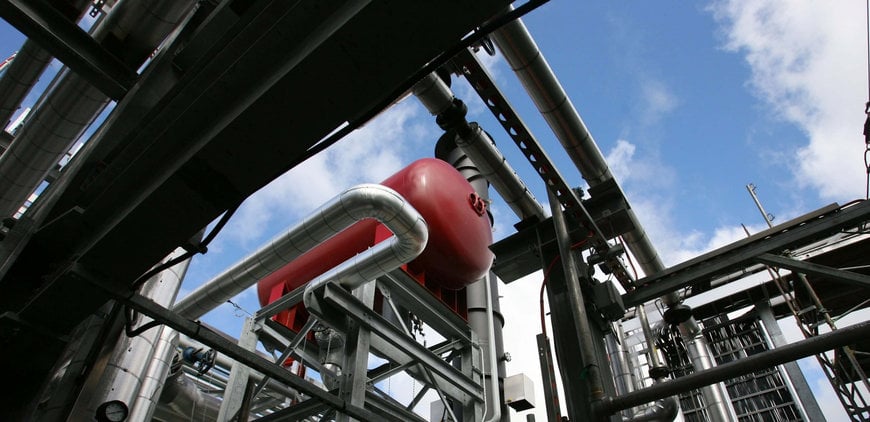
SkyNRG launched Europe’s first facility dedicated to the production of sustainable aviation fuel. Image source: SkyNRG
Besides the companies directly engaged in producing SAF, there are several others that are working on technologies used for SAF production.
Honeywell helped pioneer SAF production with its UOP Ecofining™ process – which has been used to produce the fuel commercially since 2016 – from vegetable oils, animal fats and non-food-based, and second-generation feedstocks such as camelina, jatropha and algae. Honeywell also provides Ethanol to Jet technology and eFining™, which converts green hydrogen and carbon dioxide into e-fuels. Recently the company announced its hydrocracking technology can be used to produce sustainable aviation fuel (SAF) from biomass. The Honeywell Fischer-Tropsch (FT) Unicracking™ technology takes liquids and waxes from processed biomass – including leftovers from crops, wood waste or food scraps – that can be used to produce SAF. World Energy, BP, JGC and Cosmo Oil, Acelen Renewables, DG Fuels and Jiutai are among the companies using Honeywell know-how for SAF.
Topsoe, the well-known Danish company that provides technology and solutions for the energy transition, has also developed solutions for green fuels for low-carbon travel. It has introduced the cutting-edge HydroFlex™ hydroprocessing technology to produce SAF from waste oils, fats, virgin oils, solid biomass, and plastic waste. Besites its single-point license G2L™ Biofuels uses gasification process to turn waste feedstocks into liquid hydrocarbons. Sasol, HOLBORN, Guangxi Hongkun Biomass and PT Pertamina Internasional are among the companies using Topsoe technologies to produce SAF.
KBR, another global company, has launched a differentiated SAF offering, PureSAF, in alliance with Swedish Biofuels AB, a technology developer and pioneer in cutting-edge research on biofuels. KBR is supplying PureSAF as a single-point licensor of technologies and catalysts. In addition to processing ethanol, this technology can also convert carbon dioxide and synthesis gas to SAF. PureSAF has been validated and tested by DARPA, the USAF and the Swedish Air Force as 100% drop-in military specification jet fuel. Recently KBR announced that Avina Clean Hydrogen Inc., has selected the innovative PureSAF technology for its new sustainable aviation fuel (SAF) project in the United States.
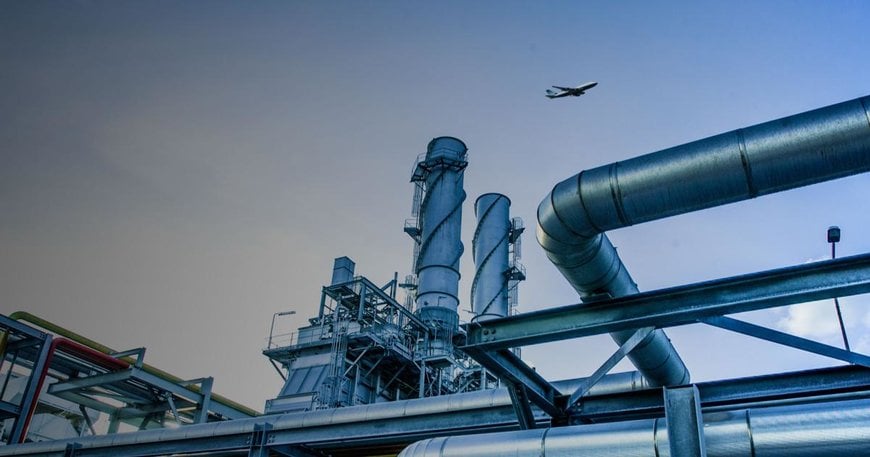
Honeywell's modular design for its new ethanol-to-jet sustainable aviation fuel technology. Image source: Honeywell
Conclusion
Will the aviation industry be able to achieve the net zero target it has set for itself by 2050? Even as the target seems daunting, it is not impossible to achieve. The aviation industry has constantly improved its fuel efficiency and reduced the carbon footprint over the last three decades, through optimised operations and improved infrastructure, apart from technological advancements. A flight today produces only half the CO2 it did in 1990. Yet as seen in the preceding paragraphs, SAF can only reduce emissions by 65% according to IATA estimates. The remaining 35% reduction must happen through other measures like new technology – electric and hydrogen (13%); further improvement in infrastructure and operational efficiencies (3%); and through offsets and carbon capture (19%).
It is still too early to predict how soon electric propulsion and hydrogen as fuel would become a reality; but there are concerted efforts in this direction by existing aircraft manufacturers and new startups. CORSIA is essentially an offset measure that will invariably diminish as more and more SAF production facilities are commissioned, but offsets shall remain one of the important pillars of net zero in aviation. With current production and projects in the pipeline, the 5% reduction in CO2 emissions by 2030 looks very much possible. So SAF remains the best option to achieve the net zero target by 2050, and for that to succeed, it needs government support and effective policy implementation backed by progressively stringent regulations.
References
1. https://www.airbus.com/en/innovation/energy-transition/sustainable-aviation-fuels
2. https://www.iata.org/en/iata-repository/publications/economic-reports/global-outlook-for-air-transport-june-2024-report/
3. https://www.iata.org/en/programs/sustainability/flynetzero/
4. https://www.mckinsey.com/industries/aerospace-and-defense/our-insights/how-the-aviation-industry-could-help-scale-sustainable-fuel-production
5. https://uop.honeywell.com/en/industry-solutions/renewable-fuels/honeywell-sustainable-aviation-fuel?utm

